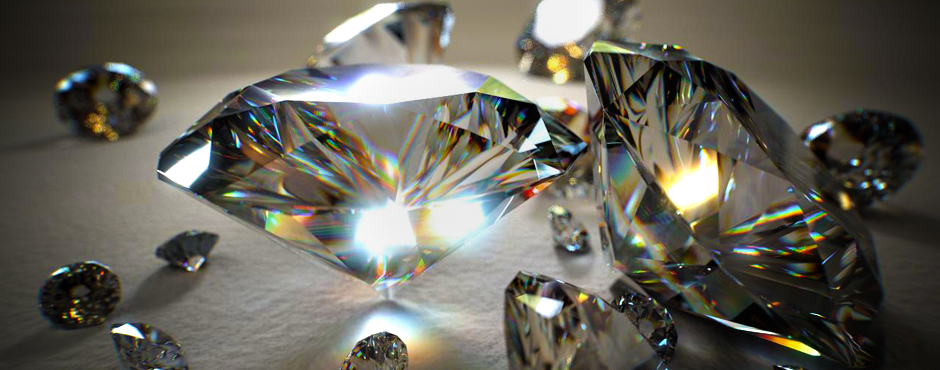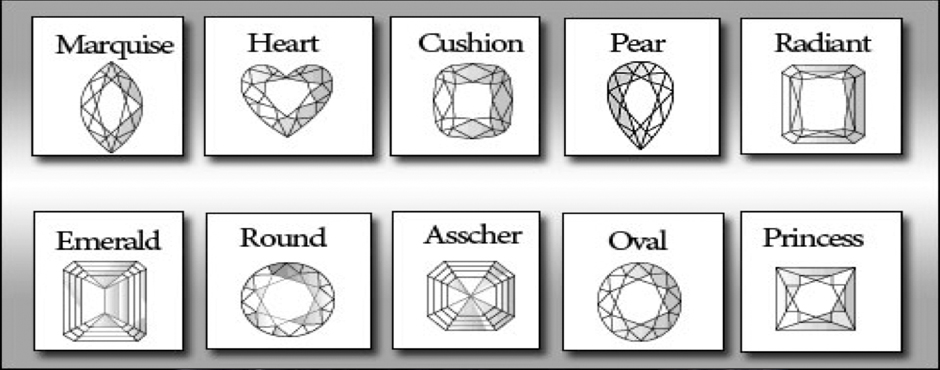Diamonds
Shape
Diamonds come in an array of shapes as shown below. G & H Pawn has these diamonds available in different qualities and carat weights.
In order to maximize this fire and brilliance, the diamond cutter must place each of the stone's facets and angles in exact geometric relation to one another. On a classic round brilliant-cut diamond, fifty-seven or fifty-eight facets must be precisely aligned. When a diamond is cut too deep or too shallow (as is most often the case), light leaks out of the bottom of the diamond instead of reflecting back to you. This explains why some diamonds are so much more brilliant than others.
There are many variables, which affect the price of the diamond regarding the cut characteristics, the carat weight, the clarity and the color.
Color
This is When light enters a diamond, it breaks into its spectral elements - brilliant reds, blues and violets. single most important determinant of a diamond's beauty, and the one element that is directly affected by human skill and expertise. More than any other quality, cut determines the fire and brilliance of a diamond.
It is for this reason that the most valuable diamonds are colorless. The absence of color allows the most natural light to pass through the diamond. Color is "graded" on a scale, from colorless to light yellow. Although the majority of diamonds appear to be colorless, virtually all have a tint of body color. If all other factors are equal, as the amount of color increases, the price of a diamond decreases (though this does not necessarily reduce the beauty of a diamond).
Carat Weight
The weight, or size of a diamond, is expressed in carats.
A carat is equal to 200 milligrams (one fifth of a gram) or 1/142nd of an ounce. G & H Pawn uses scientifically accurate electronic diamond scales which weigh diamonds to 1/200th of a carat. Carat weight is also expressed as "points". A one carat diamond is 100 points, therefore a ½ carat diamond is .50 ct. and is referred to as "50 points". Diamond weights can be rounded off to fractions,( ¼ carat, ½ carat for example), but when an exact weight is used, the reference is made as "53 points" for example and is written as 0.53 ct. A common misconception is that carat weight is a unit of size, it is not. It is a unit of weight. This is why you may see 3 diamonds that all weigh one carat (1.00 ct) but they all may appear to be a different visual size from one another. One may be 6.0mm in diameter if it is cut deeper than another which will be 6.5mm in diameter or if one diamond is cut very shallow it may be 6.8mm. How the diamond is cut will greatly affect the beauty and brilliance of the diamond as well as the price. For more information read about Cut and Ideal Cut Diamonds. As diamonds increase in size, the value increases geometrically, rather than arithmetically. A one-carat diamond can easily be worth five times as much as a half-carat diamond of the same quality.Gemstones are sold by weight, not by size or volume. This significant difference makes them more like gold and silver than other luxury products, such as furs, yachts, automobiles, or watches. Since gems are comprised of different chemical elements, they do not all weigh the same. Therefore, gemologist use weight as one means of identification.
Weight, or density, is expressed as specific gravity (SG). Diamond has an SG of 3.52, which means a diamond weighs 3.52 times as much as the same volume of water. In comparison, emeralds are lighter, with an SG of 2.72. Because each gem has its own specific gravity, gem sizes vary considerably compared with other stones of the same weight. With equal weights, emeralds are larger than diamonds; rubies and sapphires are smaller.
Gems are weighed in carats (not to be confused with "karat," which refers to the purity of gold). A carat, from the ancient Indian use of carob seeds for small consistent weights, equals 1/5 gram, or 1/142 ounce. Sizes are measured in millimeters (see below). A round one carat diamond, a standard weight in the trade, is typically 6.5mm in diameter. A round one carat ruby or sapphire, being denser, measures about 6.1mm across; a round one carat emerald is usually 6.6 to 6.7mm.
Cutting proportions for diamonds are normally much more standardized than for colored gems. When buying diamonds, the main factors that determine price are the four Cs: carat weight, color (or lack of color), clarity, and cut. When in doubt, consult an expert. With diamonds, it pays.
Clarity
Truly flawless diamonds are exceptionally rare. Most diamonds contain natural inclusions which were formed during the crystallization process. The type, size, position and quantity of these inclusions determine the clarity of the diamond. As long as these inclusions do not affect the passage of light through the diamond they will not substantially affect the diamond's beauty.
In order to maximize this fire and brilliance, the diamond cutter must place each of the stone's facets and angles in exact geometric relation to one another. On a classic round brilliant-cut diamond, fifty-seven or fifty-eight facets must be precisely aligned. When a diamond is cut too deep or too shallow (as is most often the case), light leaks out of the bottom of the diamond instead of reflecting back to you. This explains why some diamonds are so much more brilliant than others.
Precious Metals Market Prices
![]() Precious metals are rare, naturally occurring elements of high value.
Precious metals are rare, naturally occurring elements of high value.
Certifications
 The BBB Code of Business Practices represents sound advertising, selling and customer service practices that enhance customer trust and confidence in business.
The BBB Code of Business Practices represents sound advertising, selling and customer service practices that enhance customer trust and confidence in business.


